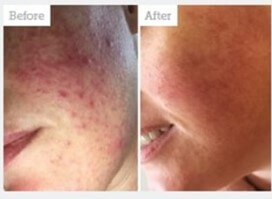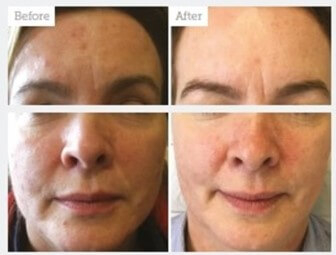Inflammatory skin disease acne vulgaris manifests itself mainly in adolescence. However, it is not uncommon for rashes to persist or appear in adulthood.
The longer an acne problem is left unattended, the higher the chance of long-term consequences – both physical (post-acne scars) and psychological (self-doubt, low self-esteem, etc.).
This article estet-portal.com presents the view of Dr. Eileen McPhillips (Aileen McPhillips) for topical treatment of mild to moderate acne in adult patients, as well as the results of treatment of acne vulgaris with cosmeceuticals.
- When is topical acne therapy appropriate?
- Topical treatment of moderate acne: case 1
- Topical treatment of moderate acne: case 2
- Limitations of topical therapy for acne vulgaris
When is topical acne therapy appropriate?
A modern cosmetologist has at his disposal a variety of methods and approaches to the treatment of acne.
These include topical cosmeceuticals.
It is not uncommon for patients to refuse systemic therapy for
- antibiotics
- – gastrointestinal disturbances, antibiotic resistance; isotretinoin
- – mental disorders, increased ICP, inflammatory bowel disease, hepatitis. It is not uncommon for patients to refuse systemic acne vulgaris therapy due to potential side effects.
This is why most patients prefertopical acne therapy
. For this purpose, preparations are used that contain the following
effective ingredients:
salicylic acid;- benzoyl peroxide;
- sulphur;
- alpha hydroxy acids;
- retinoids.
Telegram! The author uses such preparations in his practice.
After reviewing the history and examining the patient's skin, the doctor proceeds to draw up a
long-term treatment planfor acne. Best results are achieved when multiple products are used regularly.
Main Tasks:
neutralize pathogenic mechanisms;- reduce sebum production;
- speed up cell renewal;
- Suppress bacterial infection and/or inflammation.
- To evaluate the results, repeated appointments are scheduled, during which, if necessary, it is also possible to adjust the treatment plan
ia. Topical treatment of moderate acne: case 1
A 38-year-old female patient came to the doctor with a problem of acne.
The patient had previously unsuccessfully attempted self-treatment with skin cleansers. The patient refused systemic therapy due to possible side effects.
She did not take any medications and did not complain of any health problems.
During a face-to-face consultation, the author diagnosed moderate acne; acne vulgaris elements were represented by
comedonesand pustules.
Read also:International guidelines for topical acne treatment After discussion with the patient, the doctor developed a topical acne treatment program using
cosmeceuticals from theZO Skin Health. line Main
active ingredients ofpreparations:
salicylic acid;- vitamins C, A, E;
- retinoids;
- sulphur.

Fig. 1: patient before (left) and after (right) 12 weeks of moderate acne treatment with cosmeceuticals The patient was re-examined 6 and 12 weeks after the start of treatment. At each stage, an improvement in the condition of the skin was recorded.
The patient is satisfied with the result, which continues to improve
sya. Topical treatment of moderate acne: case 2
A 45-year-old female patient consulted a doctor complaining of acne.
The patient has previously tried to solve the problem on her own with the help of cosmetics.
The results of the treatment prescribed by the therapist with antibiotics and retinoids were also unsatisfactory. After stopping antibiotics, the disease worsened.
Patient refused isotretinoin therapy due to potential side effects.
During the consultation, the author diagnosed moderate acne with
comedonesand single pustules. The author has developed a topical acne treatment program based on
cosmeceuticals from theZO Skin Health line, as well as a treatment plan post-acne further.

Fig. 2: patient before (left) and after (right) 12 weeks of moderate acne treatment with cosmeceuticals The patient was re-examined at 6 and 12 weeks. Improvements were recorded at each stage.
The dose of antibiotics was gradually reduced, and 2 weeks after the start of the program, the patient completely stopped taking them.
To date, the patient is following the prescribed regimen and undergoing
microneedling sessions to eliminate post-achesnot. Topical retinoids should be discontinued 24 hours prior to microneedling.
Modern approaches to acne treatment Limitations of topical therapy for acne vulgaris
Despite the good tolerance of topical acne treatments, topical preparations can cause
skin irritation, especially in case of high doses of the active ingredients. The use of effective topical treatments for acne
is often not recommended during pregnancydue to lack of safety data.
You may also be interested in:Combination therapy acne vulgaris: results of topical preparations and apparatus techniques The limiting factor for many patients can be the
length of therapythat is needed to achieve significant results. Most topical preparations need to be applied for a minimum of 6-8 weeks before improvement occurs, and for good results – up to 6–8 months.
Regular before and after photos help to keep patients motivated, which clearly demonstrate
the progress of treatment. Topical acne therapy may be difficult if acne affects
a large area of the body(eg, face and back). In this case, systemic therapy. For some patients,
the cost of cosmeceuticals. In the treatment of
severe forms of acne with cysts or nodulestopical therapy will also not be effective. According to
magazine.







Add a comment